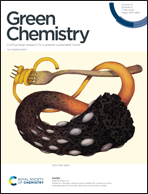Humin based resin for wood modification and property improvement†
Abstract
This study presents a novel process of wood modification employing humins, i.e. polydisperse furanic macromolecules formed during sugar dehydration. Humin valorization is more and more in the spotlight, thanks to the increased research efforts being placed by industries on biomass valorization. Here, a water soluble liquid fraction of humins was employed to impregnate wood and was polymerized within the wood using heat. This so-called ‘humination’ process was compared with the more classical furfurylation, which consists of impregnating with furfuryl alcohol (FA), and the polymerization of FA inside the wood. Confocal laser scanning fluorescence microscopy proved that furanic entities contained in the liquid fraction of humins polymerized within the wood cell walls and resulted in fluorescence similar to that seen for furfurylated wood. The humin modified wood showed lower mass increase and identical dimensional stability compared to furfurylated wood after immersion in water. Both treatments resulted in higher hydrophobicity compared to untreated wood. The elastic modulus of humin treated wood, measured by dynamic mechanical analysis (DMA), was similar to that of furfurylated wood for T < 75 °C and slightly higher than untreated wood. Finally, reaction-to-fire properties were investigated. Humin treated wood showed some advantages over furfurylated wood such as longer ignition time, slower heat release rate (−13%) and lower CO formation. This study demonstrates for the first time that humins can be used as an alternative to FA for wood modification to obtain enhanced wood products.

- This article is part of the themed collection: International Symposium on Green Chemistry 2019


 Please wait while we load your content...
Please wait while we load your content...